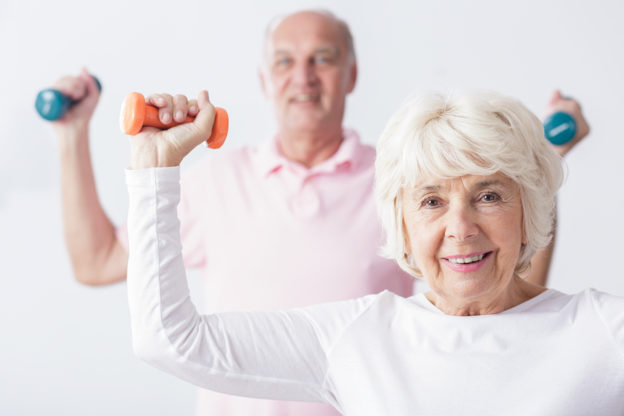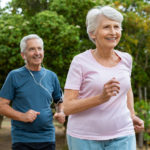By David Blyweiss, M.D., Advanced Natural Wellness
January 22, 2020
Last week, I helped my 5-year old grandson learn some healthy new habits. After doing his morning stretches, I taught him how to drop to the floor for a set of push-ups and sit-ups.
I did the exercises right along with him and — hopefully — that will start him off well.
Many of my patients could learn something here. I say this because you start to lose muscle when you’re in your 30s. And clear signs of physical decline can often be seen by the time you hit your 50s.
But most folks ignore the early warning signs.
Wondering if you’re in danger? Then, give this little exercise a try.
MD Exposes the Hidden Danger to Your Eyes

When your eyesight starts to fail, it's a real problem. Suddenly you can't go to the grocery store... you can't get to the doctor if you have an emergency... you can't meet your friends for dinner…
Your "regular" doctor doesn't have time to keep up with the latest research. And the same goes for eye doctors. They go to school to learn how to fit you for glasses and contacts, but have no way of preventing the damage and loss of eyesight that threatens your freedom and independence.
Let me show you something that explains a LOT about how your eyes work.
In my FREE Special Report, I'll show you a HUGE, untapped resource for your eyes that safely and naturally restores clear, effortless eyesight.
Click here to get started...
All you need is a 60-second timer of some sort. Even a clock with a secondhand will work…
Position yourself next to a counter or sturdy table. Then, stand up straight and place both arms straight out in front of you horizontally. Next, lift your left knee and raise your foot off the floor. This should put your knee at a 90 degree angle and your thigh parallel with your arms.
Hold this position for a full 60 seconds. Then, repeat on the other leg.
Now, if you’ve faltered during the process… if you had to swing your arms for balance, jiggle your foot around or lower your other leg to regain balance… then you may already be experiencing balance problems and muscle loss in your lower body.
If you didn’t perform well on that test, try this next test…
Are You at Risk for a Fall?
Find yourself a solid straight back chair without arm rests. The seat should be less than 17 inches tall.
Sit yourself in the middle of the seat and place your feet shoulder width apart with your arms crossed over your chest. Next, stand all the way up – and sit completely back down – as often as you can in 30 seconds.
Are You Suffering From...
- Love handles and a pot belly
- Romance that isn't what it used to
- Forgetfulness and inattention
- Low (or no) strength and endurance
- A sex drive that's shifted into neutral...or worse
If so...you may have Mature Male Burnout. Click here to discover more about this unique condition and what you can do about it.
Each fully completed sit/stand counts toward your final score. So keep track of them. (If you have to use your hands, your score is automatically zero.)
Did you complete 10… 15… 20?
This number, along with your age and gender, determines your risk of taking a fall.
For example, if you’re in your early 60s, a poor score is fewer than 14 for men and 12 for women. An excellent score is higher than 19 and 17, respectively. (Everything in between is considered average.)
This means if you’re still in your 50s – or even younger – you should perform at least 20 sit/stands to ensure your future livelihood. Click here to see where you fall.
If you haven’t performed as well as you would like on these tests, I have some ideas to help.
The Best Thing You Can Do to Save Your Muscles
First off, you can establish a new exercise routine using these tests to build strength. The more frequently you perform them, the more strength you will build.
There are also plenty of other exercises you can do to build strength and improve balance in your lower body. Squats and lunges are two of my favorites.
The key, however, is to modify any exercise program to match your fitness level. Work your way slowly up towards full fitness and balance. And check with your doctor if you have any medical conditions that may prevent you from safely performing these exercises.
Or, if you were successful with the tests, take action now so you can maintain your fitness levels for years to come.
With that in mind, here’s a quick routine that combines lower body-balance training with a high intensity workout session.
For your convenience, I’m breaking it down into two different levels — so it will work for you, no matter what your current condition.
Here’s what to do if you need to take a beginners approach…
- Walk forward briskly for ten paces. Then, stop and perform the 60 second leg lift on each leg (this is the same exercise as above).
- Walk sideways to your left for ten paces. When completed, march in place (knees high!) for 30 seconds.
- Walk backwards for ten paces. Then, bend your left leg at the knee and raise it backward as if you’re going to kick yourself in the rear end. Then, do the same with your right leg. Alternate this movement for 30 seconds.
- Walk sideways to your right for ten paces.
Perform this routine three times with a one or two minute rest between each segment.
If you’re fit as a fiddle and want to stay that way, here’s a higher intensity version of the same program…
- Run forward as fast as you can for ten paces. Stop and march rapidly in place for 30 seconds to a minute.
- Quickly shuffle sideways for ten paces to your left. When you stop, take 30 seconds or more to perform a set of fast-paced “butt-kickers” (#3 above).
- Run backwards for ten paces. Stop and perform at least 20 squats.
- Rapidly shuffle sideways to your right for ten paces.
Once again, this workout should be repeated about three times, with a one or two minute rest between each segment.
This fancy footwork, along with the muscle-building exercises in between, can do a world of wonder for your balance, agility, stability, endurance and stamina. So get up and get moving… nobody else is going to do it for you. Remember: The longest journey begins with the first step…right?
SOURCES:
Hall KS, et al. Physical Performance Across the Adult Life Span: Correlates With Age and Physical Activity. J Gerontol A Biol Sci Med Sci. 2016 Jun 29.







